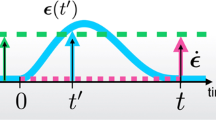Abstract
We compute the non-universal constants in the KPZ equation in one dimension, in terms of the thermodynamical quantities associated to the underlying microscopic dynamics. In particular, we derive the second-order Einstein relation \(\lambda = \frac{a}{2}\frac{d^2}{d\rho ^2} \chi (\rho ) D(\rho )\) for the transport coefficient \(\lambda \) of the KPZ equation, in terms of the conserved quantity \(\rho \), the diffusion coefficient \(D\), the strength of the asymmetry \(a\) and the static compressibility of the system \(\chi \).
Similar content being viewed by others
Notes
We point out that in [1], the authors use generic constants in front of the three terms of this equation, and they do not discuss their meanings in terms of thermodynamical quantities of the underlying systems.
References
Kardar, M., Parisi, G., Zhang, Y.C.: Dynamic scaling of growing interfaces. Phys. Rev. Lett. 56(9), 889–892 (1986)
van Beijeren, H., Kutner, R., Spohn, H.: Excess noise for driven diffusive systems. Phys. Rev. Lett. 54, 2026–2029 (1985)
Krug, H., Spohn, H. (eds.): Solids Far from Equilibrium. Cambridge University Press, Cambridge (1991)
Bertini, L., Giacomin, G.: Stochastic Burgers and KPZ equations from particle systems. Commun. Math. Phys. 183(3), 571–607 (1997)
Johansson, K.: Shape fluctuations and random matrices. Commun. Math. Phys. 209(2), 437–476 (2000)
Baik, J., Deift, P., Johansson, K.: On the distribution of the length of the longest increasing subsequence of random permutations. J. Am. Math. Soc. 12(4), 1119–1178 (1999)
Prahofer, M., Spohn, H.: Exact scaling functions for one-dimensional stationary KPZ growth. J. Stat. Phys. 115(1–2), 255–279 (2004)
Tracy, C., Widom, H.: Asymptotics in ASEP with step initial condition. Commun. Math. Phys. 290(1), 129–154 (2009)
Amir, G., Corwin, I., Quastel, J.: Probability distribution of the free energy of the continuum directed random polymer in 1+1 dimensions. Commun. Pure Appl. Math. 64(4), 466–537 (2011)
Sasamoto, T., Spohn, H.: The one-dimensional KPZ equation: an exact solution and its universality. Phys. Rev. Lett. 104(23), 230602 (2010).
Borodin, A., Petrov, L.: Integrable probability: from representation theory to Macdonald processes. Probab. Surv. 11, 1–58 (2014)
I. Corwin, The Kardar-Parisi-Zhang equation and Universality class. Random Matrices. 1, 1–76 (2012).
Spohn, H.: Stochastic integrability and the KPZ equation. Int. Assoc. Math. Phys. News Bull. 5–10 (2012). http://www.iamp.org/bulletins/old-bulletins/201207.pdf.
Nagahata, Y.: The gradient condition for one-dimensional symmetric exclusion process. J. Stat. Phys. 91, 587–602 (1998)
Brox, T., Rost, H.: Equilibrium fluctuations of stochastic particle systems: the role of conserved quantities. Ann. Prob. 12(3), 742–759 (1984)
De Masi, A., Presutti, E., Spohn, H., Wick, W.D.: Asymptotic equivalence of fluctuation fields for reversible exclusion processes with speed change. Ann. Prob. 14(2), 409–423 (1986)
Gonçalves, P., Jara, M.: Scaling limits of additive functionals of interacting particle systems. Commun. Pure Appl. Math. 66(5), 649–677 (2013)
Gonçalves, P., Jara, M.: Crossover to the KPZ equation. Annales Henri Poincaré 13(4), 813–826 (2012)
Gonçalves, P., Jara, M.: Nonlinear fluctuations of weakly asymmetric interacting particle systems. Arch. Ration. Mech. Anal. 212(2), 597–644 (2014)
P. Gonçalves, M. Jara and S. Sethuraman, A stochastic Burgers equation from a class of microscopic interactions, to appear in Annals of Probability, arXiv:1210.0017.
Bertini, L., Faggionato, A., Gabrielli, D.: Large deviation principles for nongradient weakly asymmetric stochastic lattice gases. Ann. Appl. Probab. 23(1), 1–65 (2013)
Acknowledgments
PG thanks CNPq (Brazil) for support through the research Project “Additive functionals of particle systems” 480431/2013-2. PG thanks CMAT for support by “FEDER” through the “Programa Operacional Factores de Competitividade COMPETE” and by FCT through the project PEst-C/MAT/UI0013/2011. MJ was funded by FAPERJ “Jovem Cientista do Nosso Estado” with the grant E-26/103.051/2012
Author information
Authors and Affiliations
Corresponding author
Rights and permissions
About this article
Cite this article
Gonçalves, P., Jara, M. The Einstein Relation for the KPZ Equation. J Stat Phys 158, 1262–1270 (2015). https://doi.org/10.1007/s10955-014-1158-9
Received:
Accepted:
Published:
Issue Date:
DOI: https://doi.org/10.1007/s10955-014-1158-9




